Scenic Points
Chase's later releases would become iconic for their artwork above all else. Partially because his gameplay was usually not seen as all that great, but while I don't think Chase's art is the greatest ever seen in ZZT, it's definitely well above average. Bloodlines though, is one of his earliest releases, and so the artwork still has a ways to go. Even so, what is here, ain't half bad. Certainly leagues better than what I've pulled off. There are a handful of dedicated art boards specifically for the player to take in the scenery which give Chase ample opportunity to showcase his work, along with some generally solid looking gameplay boards and cinematic sequences.

Not an art board in the traditional sense, the board for learning about the items and creatures in Bloodlines from the main menu is worth seeing for yourself. This infodump of all sorts of objects you'll encounter during the game do a lot to make it look like a rather complex game. This is the sort of board that a younger me would've definitely been inspired by, just hinting the sheer amount of stuff to look forward too. (Even if some of the major characters are a bit of a stretch. Malkovian, for example, appears for one board and has maybe one line before he's killed off.)
For more "borrowing" of characters. It's been pointed out to me by Snorb that several names are actually derived from Vampire: The Masquerade which features a "Brujah", "Gangrel", and "Malkavian" clans.

The very first scene of the game I feel is an accurate depiction of what to expect from Chase here. The variety in not just the the shapes of the trees but their size make the incredibly common scene of a ZZT forest look nicer than most.
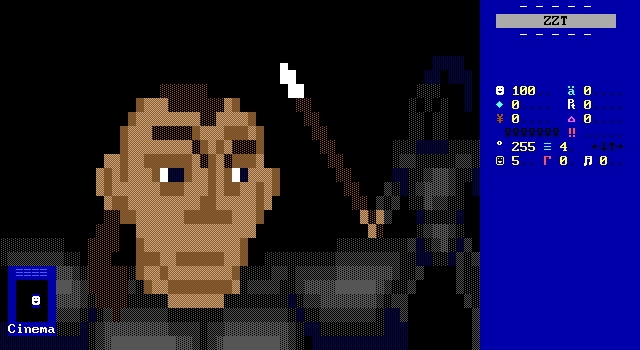
His portrait of Vorador or Malek, (neither are described physically. My money's on Malek.) is again, better than a lot of ZZT faces, but far more basic than some of his later depictions.

And I can't not comment on the unexpected and very well utilized "empty" board here. This cinema doesn't have any animation obviously, but is used to represent a sleeping Vorador being unexpectedly awakened by Malek when the vampires attack. I really don't think anybody else of the era would have dared to actually a blank board over having some snoozing objects with little Z's above their heads wake up in an animated scene. Seeing as how the next board is indeed little smiley faces fighting off smiley vampires I'd expect anyone else to have just put the dialog used here onto that board instead. Chase was interested in film and working in Hollywood, and this board really demonstrates to me how he applied film techniques to his ZZT movies.
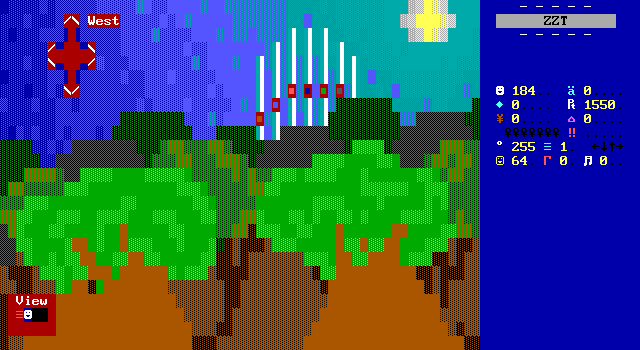
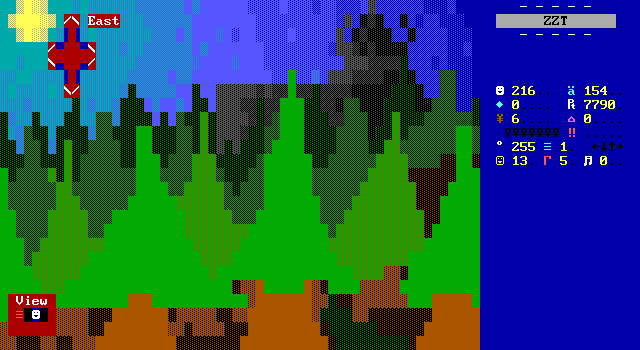
These two boards are the scenic spots used in Bloodlines. Step on a passage in the middle of the woods and you get to look at the pillars and the council chambers of the vampires. While the places in the background have care to the them, the trees are a bit more basic and look more crude than the ones seen in gameplay boards.
They are some of the rare boards which don't have Vorador's health slowly draining, so at the very least, they very much function as a place to collect yourself, take a break, and admire your surroundings for a moment.
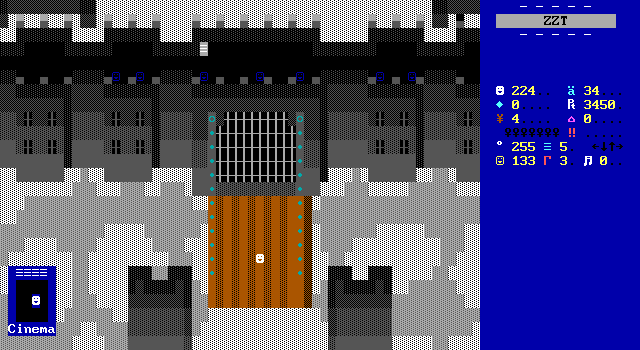
Vorador's return trip to the Sarafan headquarters is the clear winner here in terms of visuals. I was quite impressed with this massive fortress, in particular the chains for the drawbridge. ...Although I'm now noticing that the drawbridge just seems to be placed above snowy ground and not a body of water or pit or something.
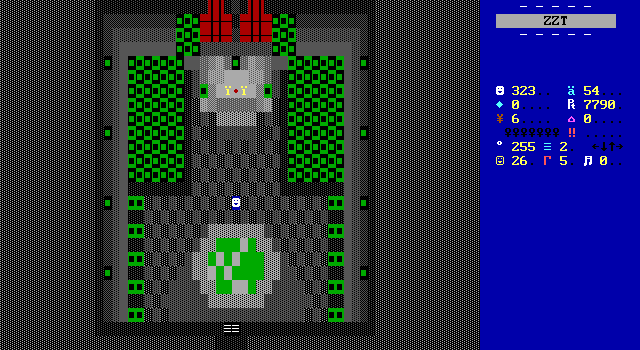
Some of the special locations like the spirit forge look pretty cool. Good use of color, plus some fancy window design. It's a lot of effort for what's ultimately a one time trade of health for ammo.
Plot Summary

Bloodlines sticks out to me from most ZZT games by having a story that I actually got invested in. Despite numerous games from this era of ZZT attempting to tackle more complex plots and heavier subjects compared to the early days of finding purple keys or missing monkeys. From beginning to end, the story unfolding here is a pretty impressive one with Vorador dealing with rejection from his peers, fear of succumbing to his dark side, and reluctantly forging a new path forward with his new vampire comrades before embracing his transformation.
Perhaps I need to read more vampire fiction, (almost certainly,) but I haven't seen anything like this before, where the transformation from man to monster doesn't occur quickly like in zombie stories or from uncontrollable events like werewolves dealing with a full moon. It's very ambiguous what exactly "becoming" a vampire means here. Vorador doesn't immediately turn on the Sarafan he's dedicated his life working with, and there's some compelling drama with his rejection from the order upon his return. It seemed like there were a lot of directions things could go. There were plenty of questions as to whether or not it was possible to cure or resist his vampirism, or if perhaps the vampires were being put into terrible situations as they were cast out from society.
A decent amount of the game's writing leans in heavily on pigeon olde-English with plenty of thees and thous that in ZZT worlds by teenagers come off to me less as an immersive historical fiction (with vampires) and more as teenagers wanting to appear sophisticated. Thankfully it's not too grueling to get through and doesn't really make anything insufferable. It seems to mostly be used when dealing with fellow Sarafan rather than the entire cast, appearing less frequently as things progress.
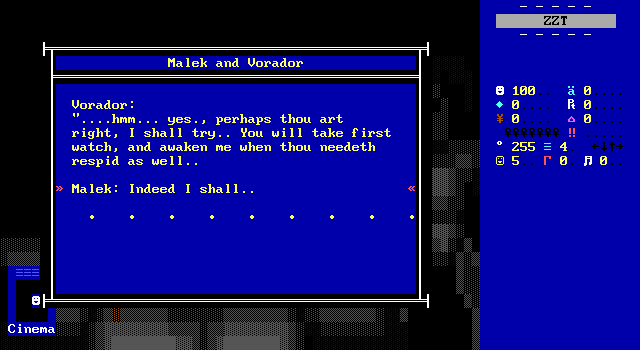
"Respid" aside, the game's story complements the gameplay rather well, making for yet another aspect of the game that comes off as better than most of its contemporaries. Had this come out in more modern times I'd still be impressed.
So of course, Chase's insistence of not bringing up Legacy of Kain means I have to take all of this with a grain of salt. Maybe I'm actually just complementing the story of a 1996 PlayStation game, in which case... actually yeah given what typical video game stories were like then that praise applies all the same. It's just a matter of whether or not it's Chase that deserves the accolades.
Expect some spoilers ahead!
The game opens with a multi-board cinema introducing us to Vorador and Malek. Vorador feels the woods the two are currently in aren't safe to camp, and while Malek admits that Vorador's insight has never been wrong before, he uses his status as commanding officer to turn the suggestion into an order and the two set up camp.
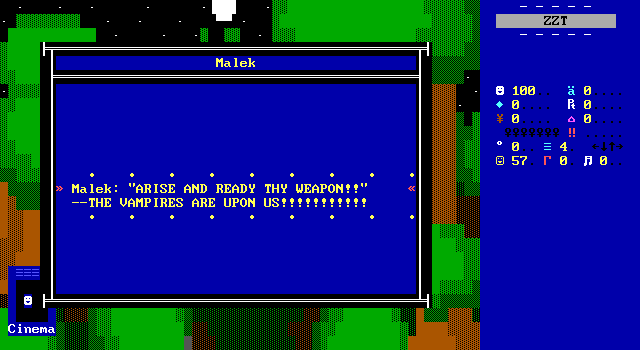
Overnight, a group of vampires descend on the two, and just when Vorador and Malek seem to have won, another knocks Malek aside and inflicts a fatal blow onto Vorador. The scene ends here, though some extra dialog exists in the scene that makes it more clear what's supposed to be happening. The vampire knows it's not Vorador's fate to die here and blesses him with the gift of vampirism which Vorador fruitlessly rejects.
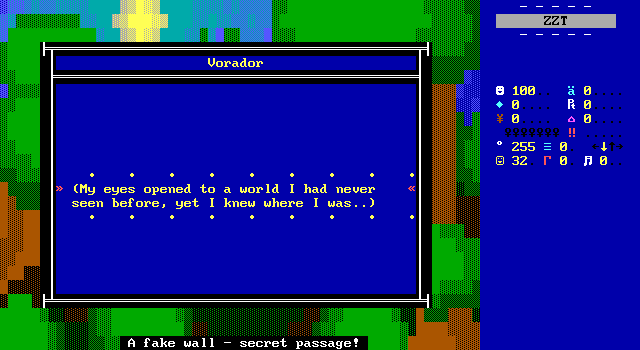
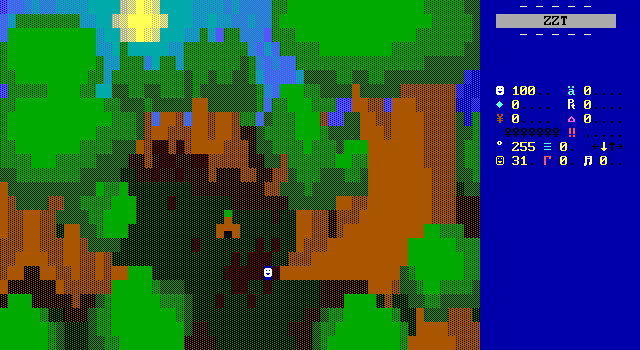
Come morning, Malek is gone, and Vorador recognizes himself as having been reborn a vampire, noticing that things that are alive now seem dead and vice-versa. The player takes control of Vorador and wanders in the woods a bit, fighting off some wolves and feeding on their blood (THE HUNGER is now active after all). There's opportunity to visit a village where everyone immediately runs away. Vorador makes no comment on this and depending on the player's actions may opt to drink the blood of the entire populace.

Eventually Vorador reaches the pillars of Nosgoth, which represent the various guardians (possibly gods?) of the world. He prays to the pillars for direction and a voice on the wind speaks a single word: RETURN. Determined that he can escape what has befallen him Vorador heads back to the Sarafan headquarters in hopes they will accept him and help him find cure.
SO YOU TURN INTO A BAT AND FLY THERE.

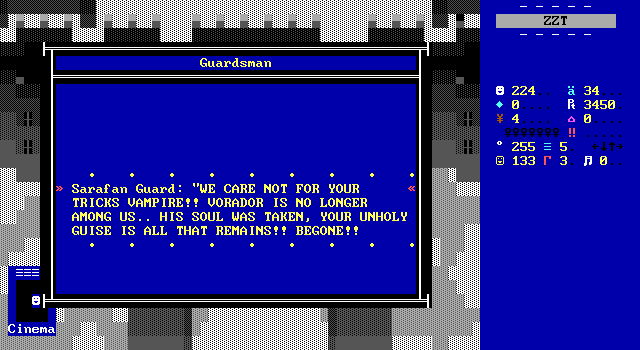
The guards are shocked to see you've return and cast you out immediately, believing your pleas to be the tricks of a soulless creature of darkness and not the Vorador they knew. Malek heads outside and Vorador begs him to get them to listen, but Malek agrees with the others and only suggests that Vorador be cleansed with holy fire.
Malek: "Vorador? Can it be
Thou??
Vorador: "MALEK!!! GOOD TO SEE THOU ALIVE!
YOU CAN HELP ME FRIEND!! TELL OUR BROTHERS
WHAT HAPPENED THE NIGHT LAST!! SURELY
THEY WILL UNDERSTAND AND HELP CURE ME OF
MY PREDICAMENT!!
Malek: .......
Vorador: "MALEK THOU ART MY FRIEND!!
PLEASE!!... TELL THEM!!"
Malek: This ...
..........creature ...is a beast of the
night!! NOT EVEN GOD CAN HELP HIM NOW!!!
-WE MUST DESTROY IT AT ONCE BROTHERS!!
• • • • • • • • •
It's a surprisingly powerful scene, and given how early it is in the game, I was very much surprised that Chase had managed to get me invested in characters with little more than two cutscenes. Of course, it is a bit harder to take Vorador's plight as seriously if you've consumed the blood of an entire village beforehand. Vorador has no moral quandaries with this as he does so, and he doesn't bring it up to the Sarafan for obvious reasons.
Returning to the pillars more despondent than ever, Mortanius, guardian of the pillar of death reveals himself and offers guidance. He explains that the vampire that turned him is Yanos Odrin, and that to fulfill his destiny they must meet again. More importantly, he reveals that Vorador's opinion that Malek and the Sarafan are just and righteous may not be so true, telling him that Malek had purposely allowed the attack to happen and left Vorador for dead so that he could make up a story and return a hero.

It hits Vorador quite hard to have to question his best friend's motives, yet he finds Mortanius's logic convincing. Perhaps the best thing about Bloodlines is that while Mortanius's interpretation of events is plausible, there's no real evidence. While Vorador does accept it pretty quickly in his grief-stricken state, for the player, the truth remains in question for the rest of the game, adding quite a lot of severity to the events that follow and how justified they might be.
Mortanius tells Vorador he can find Yanos in the land of the dead: Jy'had. Vorador's journey continues through the woods of the Southern cross, across a river and through a cave before he arrives in Jy'had. There's a seed of doubt in Vorador's mind, and he tells himself that he's only going to meet with Yanos to get information and hope that it may provide clues for a cure.
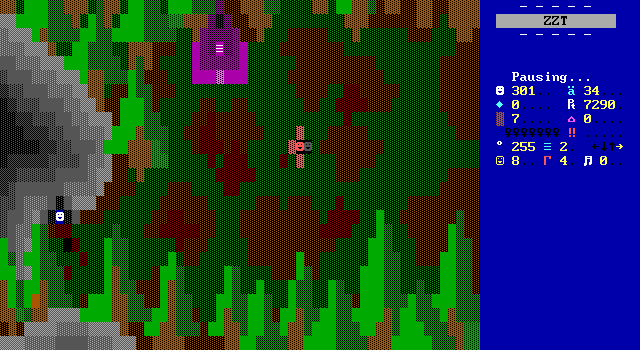
On the outskirts of the city, Vorador meets Brujah who knows Vorador's name without telling, revealing that all vampires are one, capable of reading the thoughts of others. Vorador is able to exercise this power himself and learns Brujah's name without asking as well. Afterwards he decides to be careful with his thoughts in order to keep the other vampires from learning too much about him.
Upon reaching the council chamber of Jy'had, Vorador meets Yanos once more. Yanos laughs as Vorador describes his vampirism with works like "condition" and "curse". Yanos provides his own perspective on what happened that fateful night, claiming that he had sensed that fate had more in store for Vorador and this his actions that night were to save him from Malek. He claims that without the attack happening, that Malek's plan was to kill Vorador in his sleep and make up a story of heroism where Malek fought off the vampires that Vorador foolishly allowed to the camp.
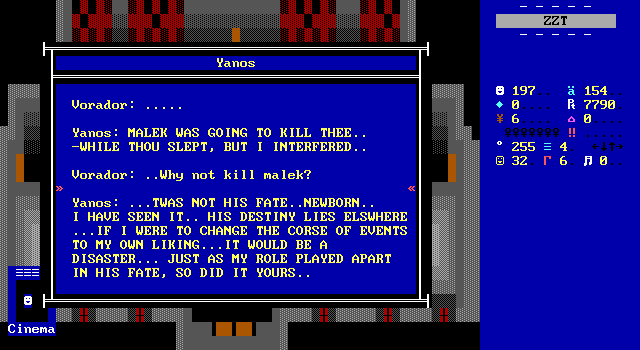
Vorador, as if speaking on behalf of an observant player asks the question of why not just kill Malek instead, but once again fate is the answer. Malek too has a fate that he cannot escape so the only thing to do was to attack the camp and turn Vorador into a vampire so that he could live after death. I was not an observant player, and so I was quite impressed that an easy plot-hole was addressed that I overlooked. (Whether or not "uhhh fate" is a valid answer to all plot questions is another story.)
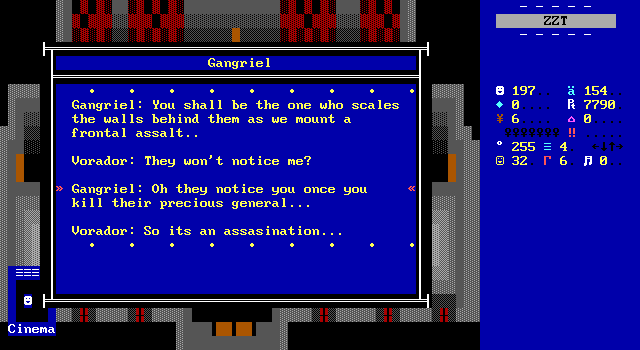
Now Vorador is convinced. He seeks vengeance and begins to reconsider this whole "curse" thing. Gladly volunteering for a mission when Yanos and the other members of the council discuss how Vorador's knowledge of the Sarafan could make him a very potent force. The plan is for a large group of vampires to assault the gates of a Sarafan fortress while Vorador sneaks inside to assassinate general Malkovian. Without their leader the vampires can overwhelm the fortress and take over the area.
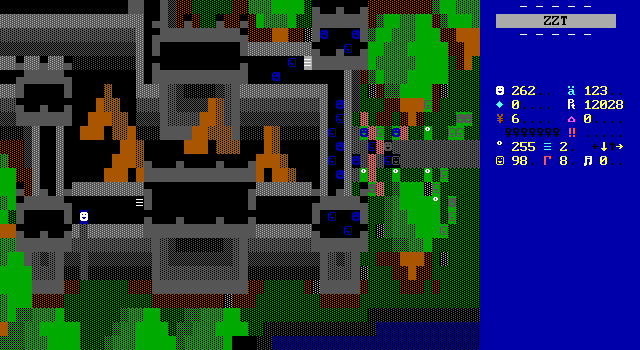
A neat cinema plays out at the fortress where the vampires' assault is going on while the player is still in control of Vorador during the scene, throwing a rope and scaling the walls on his sneaking mission. Using knowledge from when he was stationed there Vorador quickly reaches the barracks and tracks down Malkovian who cowers in fear at Vorador's presence before being swiftly killed off.
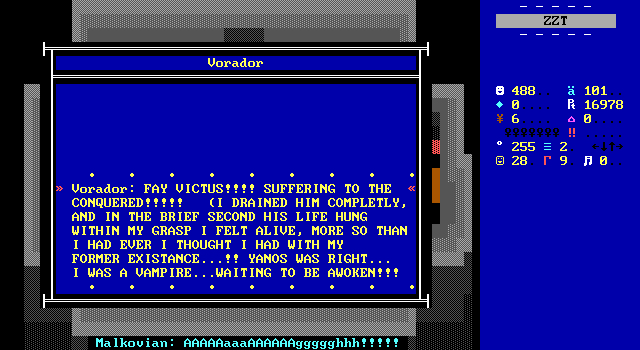
Vorador is out there reader, and he's loving every minute of it. At this point Vorador is not just convinced that he wants to be on the side of Yanos and the other vampires, but that his "affliction" was a blessing, and he has been reborn as something far better and more powerful than he was before.
After a brief celebration outside the gates Vorador returns to the council to receive his next mission. The plan is to continue the assault on Sarafan fortresses swiftly and without mercy. Rumor has it that the Sarafan are developing a new weapon, and so they must be destroyed before it can be completed. Vorador is told not to rush in just yet, but to first speak with the oracle and learn what the weapon is so that they can learn exactly what needs to be done.
Backtracking (made quick thanks to Bat towers), Vorador returns to the fortress, but this time continues onward, reaching another village where he can quench his thirst and a second blood fountain. From there it's possible to use the newfound strength to pass a large boulder (the size of the small boulders) and make way to the oracle.
...And then the game ends.
Please Insert Disc Two
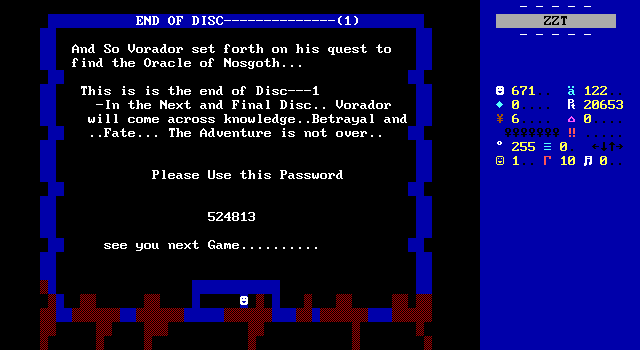
Splitting the game up into two "discs" is nothing too surprising for a game from 2000, and if anything would be seen as a mark of quality to have made a game "too big for ZZT". The wisdom of the time was that if your game broke the 300 KB barrier, to get a new file going lest you run the risk of creating a file so big ZZT can't open it. In reality, by this time period unless you were running on some outdated hardware (totally a possibility, plenty of ZZTers did work on older hardware they had easy access to), 300 was definitely earlier than necessary for a split when you're running ZZT from Windows. Bloodlines Disc 1 as released definitely abides by the rule fitting into 302 kilobytes of space.
Sometimes authors planned for multiple files, but this instance looks to have been an unexpected surprise for Chase. The file ends with ten blanked out boards, almost certainly imported into the second file in order to get the file size down and to split the game on a clean break point after finishing the assassination mission and receiving your next mission. This does have the issue though that the Mist card can't be obtained until you're already able to end the game, making going back to the earlier dungeons for more supplies pointless. Had the adventure managed to be contained in a single file this wouldn't have been a problem. Instead all those supplies have to be discarded for a new start in disc two.
Bloodlines includes a handful of references to things that make the split appear to have been unplanned. The manual from the menu describes a few other powers Vorador can acquire with notes that they can be found in the second disc. These include a "Wolf card" and "Mind card". The greater plot involving Mortanius and the pillars is virtually nonexistent in the first disc.
The world map features landmarks numbered from 0-4, and then the Sarafan base jumps up to number seven. Other villages visible from the map have no number assigned to them.
Disc two was released only a few weeks after the first disc so if anything I'm surprised the first disc was released by itself, but it wound up scoring a Game of the Month award for it, so I can't argue with the results of that decision. The third release of the game bundles both discs, and is identical to the original release. This is a bit of a shame if just because there are some coding errors in disc one that the time between discs should have been the perfect time to fix them before a definitive release of both halves. Fortunately, these coding errors aren't game-breaking.
Bats Aren't Bugs!!!
Incredibly, the opening scene in which Vorador gets bit is broken! Watching the scene, it looks like Vorador and Malek successfully fend off the initial vampire attack that leads to Vorador's affliction. It turns out that there are a few lines that don't fire to incorrect spellings of object names. This prevents a pretty important conversation between Yanos and Vorador where a dying Vorador is unwillingly turned vampire. Without this extra dialog the scene just kind of stops abruptly with the next board covering Vorador's transformation.
All these cutscenes in Bloodlines can be skipped at any time and it's that fact that allows the missing conversation to not prevent the game from moving ahead. I assumed this was just less than stellar storytelling until I went to look up character names and found the text. Also: I had to look up character names because in the introduction Malek is called "Rahn" instead. That's a weird thing to miss.
Not so much a bug, so much as flawed design, at one point Vorador has to go through a cave. There's an area behind some ZZT boulders that requires careful pushing to to be able to access. Since the room is dark the player won't know that it holds a lever that's required to open the exit making it very easy to accidentally get yourself stuck. I just think this needs something to make it more obvious that you must get through the boulders to progress to avoid the risk of a player considering the cave to be part of the game's "dungeon" boards and thus optional.
On the other side of the cave there's another minor bug where Vorador runs across the vampire Brujah feeding on a human. A trigger activates the dialog between them that provides some useful information on where to go next. Unfortunately the object that checks for the player passing a point to trigger runs at the default cycle three so there's only a 1/3 chance of a player running across the board activating the scene. The good news is that if you know where the object is, they can just stand there for a moment to get the dialog to appear.
For a stroke of luck, there are a few programming errors that mix up commands that ZZT's parser just so happens to end up allowing to function regardless. These are a lot of instances throughout the game where two commands are mixed up with one another resulting in a lot of #LOCK TOUCH/#UNLOCK TOUCH instead of #ZAP TOUCH/#RESTORE TOUCH. The invalid commands do properly lock/unlock the object, which ends up having the same effect of the player being unable to touch boulders to move them until Vorador has the ability to do so. #LOCK TOUCH shows up in a lot of objects throughout the game, pretty much any time an enemy is dying. Here it also ends up working out just the same. Chase lists himself and Hydra78 as testers so I doubt this would have gotten through had it causes issues as it would make enemies not disappear ever, and as unlikely as not noticing that a chunk of dialog isn't firing, I can't imagine missing this one.
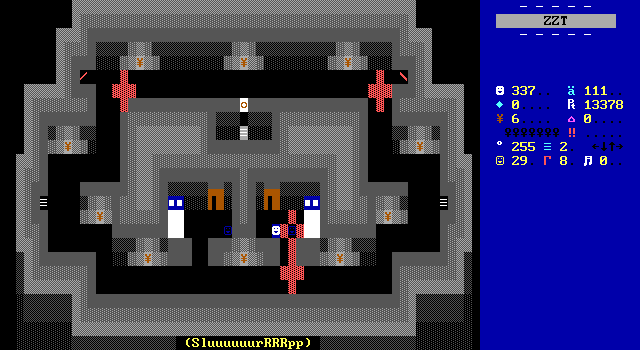
Speaking of enemies not disappearing, one guard encountered during the assassination plot is actually missing their #DIE command which allows the player to collect infinite blood and score if they wish. At thirty health restored per feeding, Mr. Slurp here is a handy little debug tool I suppose.
Final Thoughts
Originality and other issues with Chase aside, what we have here in Bloodlines is a very compelling story that develops between engaging gameplay that's encouraged through THE HUNGER, along with extra challenges/diversions in dungeons, and topped off with getting to flex on unsuspecting villagers with your unmatched strength. My notes for this one are so short. I enjoyed everything about the game, eagerly running off to assassinate the general, hoping to get some concrete answers about whether or not Malek truly betrayed Vorador or not, and very much was excited for where things could go whether it was the truth or not. I had fun exploring the dungeons. I had fun drinking the blood of wolves, bears, and people. Chase went all out in terms of placing down Bat Towers for fast travel, sometimes even as little as two boards away from each other, but that made for an incredibly fast paced game where the numerous excursions to already seen boards wasted as little time as possible.
The bloodsucking mechanic is a great motivation to get the player interested in combat when it might otherwise feel dull, and yet the numbers around it are balanced in such a way that you aren't going to have to actually worry about running out. Of course, you won't know this as you play which is what makes it so effective. Only at one point does Vorador traverse a few boards without a source of blood, and with no need to stop and fight you can cross those boards with little loss to your health.
The power-ups don't amount to anything radical, but the framing around makes it easy to believe otherwise. The blood fountains Vorador drinks from feel ornate. The towers for fast travel feel like natural points of interest within the universe. Nosgoth ends up feeling like a proper place and not a world designed entirely to support a video game.
At one point I mistakenly thought the game was actually bugged out, not realizing there were two different flags for different levels of boulder crushing strength which made me curious if any changes were made to the game in the complete release that includes disc two. While there aren't any it got me to take a small peek at the second disc where I got to see of Chase's other ideas that would be added to the sequel. One that really impressed me was the "Mind Card" which allows you to hypnotize villagers to have them give you items instead of (or perhaps just before) draining their blood. I hadn't even considered there to be any issue with the villages in disc one, but love the idea of having to weigh whether or not to drink blood now and forego items or to return later with the card.
The way Chase pulls everything together here is honestly quite remarkable, and while this first disc received a Game of the Month Award I'm surprised I hadn't heard more about it back in the day. This is incredibly impressive for a second ZZT release that compares favorably to major releases by other big name ZZTers of the era such as coolzx, Chronos, Tseng or Hercules and Hydra.
The uncredited source material is definitely a mark against it, and with the story having impressed me so much it sucks to have to downplay that aspect of the game's many positive qualities. Bloodlines ends with a lot of questions, which may or may not be answered in its second file. I genuinely want to know if Vorador is being manipulated, or if Malek truly betrayed him for power. I want to find out if Vorador's vampirism could have been cursed, or accommodated in a way that didn't involve killing people. I want to learn if Vorador's acceptance of Yanos's missions comes from wanting revenge, realizing that the vampires must survive, or if his soul has indeed been corrupted fully. And lastly, I want to see the impact of Vorador's assault on Steinchencroe and other Sarafan encampments in the future.
But then, of course, there's Chase's legacy mentioned earlier, which will certainly prevent me from bringing this one up when recommending ZZT worlds to others. Bloodlines should have been an all time classic. Instead, on the list of must-plays, Bloodlines will have to deal with being sent to the very back of the line. There are other ZZT worlds that need to be praised, celebrated, and shared before this one. Sorry Vorador, luck was never your strong suit.


